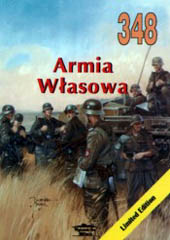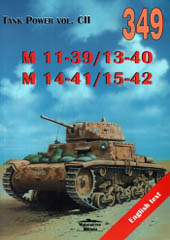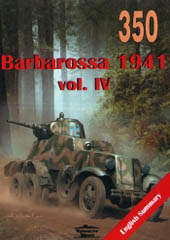New decal sets for Luftwaffe Bf 109 F-4/Trop and Ta 152 H from EagleCals:
New decal sets for Luftwaffe Bf 109 F-4/Trop and Ta 152 H from EagleCals:
The Famous Fourth, The Big Picture, Army Pictorial Center, U.S. Army — The history of the 4th Infantry Division.
Three recent and upcoming WWII titles from Wydawnictwo Militaria:



When the Allied forces first encountered the Tiger II in Normandy in the summer of 1944, the panzer was briefly referred to as the “Pantiger”. The Associated Press picked up the name “Pantiger” in their article on August 19th:
Germans have thrown a huge new, heavily armored tank into action on both the Russian and northern French fronts in an effort to stem the Allied advances, but first reports denied it was a “super weapon.”
One of the new monsters weighing over 65 tons and with six inch armor plate—an inch and a half thicker than anything the enemy yet has put into action—was taken by the British on the Orne river front. The tank was a victim of a mechanical breakdown and never had fired a shot in battle.
Christened the “Pantiger” by its captors, the tank combines the best features of the Nazi Tiger and Panther tanks, which weigh 45 tons each. It is 23 feet long and over 11 feet wide, has an extra wheel on each side of its tracks and a huge, clumsy looking turret.
The name “Pantiger” was still being used as late as the publication of Tactical and Technical Trends, October 1944.
PANTIGER, A REDESIGNED TIGER, NEWEST ENEMY HEAVY TANK
A new 67-ton German heavy tank—referred to variously as Pantiger and Tiger II—has been employed against the Allies this summer in France. Actually a redesigned Tiger (Pz. Kpfw. VI), it mounts the 8.8-cm Kw. K. 43 gun. On the basis of a preliminary report, the general appearance of the new tank is that of a scaled-up Pz. Kpfw. V (Panther) on the wide Tiger tracks. It conforms to normal German tank practice insofar as the design, lay-out, welding, and interlocking of the main plates are concerned. All sides are sloping. The gun is larger than the Panther gun, and longer than the ordinary Tiger gun. Armor is also thicker than that on either the Panther or the Tiger. The turret is of new design, with bent side plates. In all respects the new tank is larger than the standard Tiger.
From Bombardiers’ Information File, U.S. War Department, March 1945:
Vest Type Emergency Kit
The following items of equipment are carried in the packets of the vest: 1 hat (yellow on one side, OD on the other)1 pair polaroid sun goggles1 signal mirror, with lanyard1 sharpening stone1 fishing-sewing kit, in plastic container1 collapsible spit and gaff1 plastic water canteen (3-pint capacity)1 Boy Scout knife1 large knife (with 5-inch saw and blade)1 package toilet tissue10 yds bandage (with sulfa powder)1 waterproof match-box with compass20 matches14 fire starting tabs1 burning glass1 signal whistle1 oil container1 waterproof cover for .45 cal. pistol20 .45 cal. shot cartridges1 First Aid Kit1 Survival manual2 vest-kit rations in tin containers2 five-minute signal flares1 mosquito headnet1 collapsible container for boiling water1 pair woolen insert gloves1 pair leather outer glovesVest, Emergency Sustenance, Type C-1 was developed for the use of each crew member of an airplane forced down in isolated regions. It consists of an adjustable vest-like garment, fitted with pockets into which the items of the kit are conveniently stowed. The vest is to be worn under the life preserver vest and parachute. PROTECT YOURSELF: Before taking off on a flight over inaccessible or mountainous country, the Arctic, jungle, desert, or ocean, check your vest and be sure it contains all the necessary equipment. If it does not, check with your Personal Equipment Officer.
Shown below are Bundesarchiv photographs of the German Sd.Kfz. 10 halftrack. (Sd.Kfz. = Sonderkraftfahrzeug or special-purpose motorized vehicle.) The Sd.Kfz. 10 was used extensively by the German military throughout WWII as a light tractor and prime mover with over 14,000 produced. The Sd.Kfz. 10 chassis also formed the basis for the Sd.Kfz. 250 light armored personnel carrier.
New 1/48 Resin Figures from Total War Miniatures:
WWII color film produced by Bell Aircraft Corporation showing the design, assembly-line construction, and deployment of Bell Aircraft’s fighter planes with emphasis on the Bell P-39 Airacobra.
New limited edition 1/35th-scale Japanese Type 95 Ha-Go light tanks from Fine Molds.
1/35th IJA Type 95 Light Tank Ha-Go with Smoke Discharger – Limited Edition (FIN35516)
1/35th IJA Type 95 Light Tank Ha-Go, Iwo Jima – Limited Edition (FIN35616)
See Also: Japanese Type 95 Tank Evaluation; “Japanese Light Tank” from Tactical and Technical Trends; Japanese Tanks and Tank Tactics; “Modernized Tanks, with Heavier Armor, May be Expected” from Tactical and Technical Trends
A description of Airborne Transmitting Equipment AN/APT-1 used to jam enemy radars in WWII from Graphic Survey of Radio and Radar Equipment Used by the Army Air Forces, Army Air Forces, Air Technical Service Command, Wright Field, Dayton, Ohio, February 1945:
Transmitting Equipment AN/APT-1 is an airborne transmitter used to jam enemy radars in the 95-210 mc. frequency range. This band includes most of the enemy early warning radars such as the German Freya, Hoardings and Wasserman and Japanese radars of equivalent type. The equipment employs the DINA (Direct Noise Amplification) type of transmission and may be used either as a spot jammer or as a barrage type jammer.
The carrier frequency is suppressed and all of the output power is concentrated in the side bands, affording more effective jamming coverage with less power. It will effectively screen an AN/APT-l equipped bomber to within two miles of a Freya radar.
Radar Transmitting Equipment AN/APT-1 (Installed in B-17) may be used for spot or barrage jamming of enemy radars in the frequency range from 95 to 210 mc. (i.e. German Freya or Japanese equivalent types.)
For barrage jamming the equipment is adjusted to the required frequency prior to take-off, after which only the power output need be controlled.
For spot jamming the set must be tuned in flight by means of the control unit. Employing R-F Amplifier AM-14/APT or AM-18/APT the output of the equipment can be increased effectively. Two sets of three antennas are available for complete frequency coverage. All are of the quarter-wave stub type. One set is designed for vertical mounting and the other set is designed for mounting at an angle of 45 degrees.
Power is obtained from an 80/115 volt, 400-2600 c.p.s., a.c. source and a 28 volt d.c. source.
Test equipment required for the maintenance and tuning of the equipment includes Test Set I-139-A, Amplifier Alignment Unit TS-92/AP, Radio Frequency Wattmeter TS-118/AP or TS-92/AP, Pickup Assembly TS-131/AP, Test Set I-56-K and Frequency Meter TS-174/AP.
Army Supply Program requirements as of 20 November 1944 were 4,895 for the calendar year 1944 and 3,086 for 1945.
POWER INPUT 325 WATTS POWER OUTPUT 30-8 WATTS (All sideband) FREQUENCY 95-210 MC. TYPE OF SIGNAL DIRECT NOISE
TUBE COMPLEMENT NO. TYPE NO. TYPE 2 5R4GY 1 6X5GT 3 6AC7 1 931A 2 6C4 2 832* 1 6V6GT/X 1 829B* *One 829B substituted for one 832 for increased power over 95-150 Mc.
(i) Antenna Stubs AT-36/APT, AT-37/APT and AT-38/APT are similar except they are for vertical mounting. (ii) Control Unit C-58/APT-1. (iii) Radar Transmitter T-28/APT-1.
RADAR SET AN/APT-1 TOTAL WEIGHT 70 LBS. Component Nomenclature Size Weight Radar Transmitter T-28/APT-1 7 5/8″ x 10 1/8″ x 21 3/4″ 43 Lb. Control Unit C-58/APT-1 3 1/2″ x 3 1/2″ x 2 1/2″ 1 1/2 Lb. Mounting Base MT-171/U 2 1/4″ x 10 5/8″ x 22″ 3 1/4 Lb. Mounting Base MT-114/APT-1 5″ x 5″ x 3/4″ 1 1/4 Lb. Antenna Stub AT-36/APT or AT-41/APT Length 16 1/2″ 6 1/2 Lb. Antenna Stub AT-37/APT or AT-42/APT Length 22 1/2″ 6 1/2 Lb. Antenna Stub AT-38/APT or AT-43/APT Length 29″ 6 1/2 Lb. and includes plugs, adapters, and misc. cables.